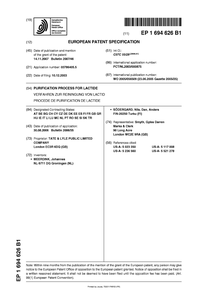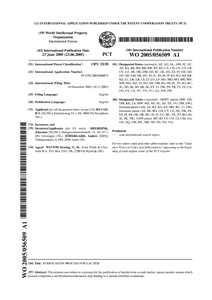The invention relates to an improved process for the purification of lactide from a crude lactide vapour product comprising at least lactide, lactic acid, water and linear lactic acid oligomers.
DOCUMENT

The inventation relates to a process for the purification of lactide from a crude lactide vapour product stream which process comprises a rectification/condensation step to a lactide-enriched condensate.
DOCUMENT

A novel synthetic approach to 2,6-bis(acrylamido)pyridine (BAAPy) has been developed, producing a dual-function monomer able to self-crosslink while providing functional binding sites through its amide and pyridine groups. The monomer's structure and purity were confirmed through NMR, FTIR, and HPLC analyses. Poly(BAAPy) was subsequently synthesized and employed in the purification of stilbenes, including t-resveratrol, t-ε-viniferin, and t-piceatannol, all extracted from grape canes. These stilbenes, widely recognized for their antioxidant, antifungal, and antimicrobial properties, are valuable phytochemicals. Grape canes, a by-product of grapevine pruning, serve as a natural and cost-effective source of these bioactive compounds. Using a single-step adsorption–desorption process with an ethanol–water solvent system, the method achieved a 13-fold enrichment of stilbenes with gravimetric purities over 37%. The dual functionality of BAAPy eliminates the need for external crosslinkers and enhances adsorption capacity.
DOCUMENT
The intermittency of renewable energy technologies requires adequate storage technologies. Hydrogen systems consisting of electrolysers, storage tanks, and fuel cells can be implemented as well as batteries. The requirements of the hydrogen purification unit is missing from literature. We measured the same for a 4.5 kW PEM electrolyser to be 0.8 kW for 10 min.A simulation to hybridize the hydrogen system, including its purification unit, with lithium-ion batteries for energy storage is presented; the batteries also support the electrolyser. We simulated a scenario for operating a Dutch household off-electric-grid using solar and wind electricity to find the capacities and costs of the components of the system.Although the energy use of the purification unit is small, it influences the operation of the system, affecting the sizing of the components. The battery as a fast response efficient secondary storage system increases the ability of the electrolyser to start up.
DOCUMENT
INAUGURAL LECTURE The world is in disarray. Species are extinct, climates are changing, we are becoming unhealthier.To liberate ourselves from this doom scenario we need to take care of ourselves and our environment. The solutions of former generations offer no future solace. Moreover, these caused the current problems. Instead of exploiting our environment for energy, resources and capacity we need to increase the potential for the recuperation of the environment, the planet and our minds. Instead of taking, giving!The reciprocity of the urbanized land we live in should be our main objective. The professorship Spatial Transformations - Sustainability will therefore design and plan for our physical and mentalcity and surroundings. This way the city becomes a purification machine for polluted water and acts as a net carbon sink. The city becomes a source of biodiversity, transformed into an urban nature reserve. Food will be produced that extends our lives. And wouldn’t it be nice to see the city as a place for contemplation so our mental abilities can grow instead of vegetating in dull offices? The city should offer people a healthy life, replenish resources and be beautiful. The professorship contributes to educating a new generation finding extraordinary solutions for current problems. With creativity, initiative and a healthy dose of disobedience this must work!
DOCUMENT

A bacterium belonging to the Bacillus firmus/lentus-complex and capable of growth on native potato starch was isolated from sludge of a pilot plant unit for potato-starch production. Utilization of a crude enzyme preparation obtained from the culture fluid after growth of the microorganism on native starch, resulted in complete degradation of native starch granules from potato, maize and wheat at a temperature of 37°C. Glucose was found as a major product. Production of maltose, maltotriose and maltotetraose was also observed. Native-starch-degrading activity (NSDA) could be selectively adsorbed on potato-starch granules, whereas soluble-starch-degrading activity (SSDA) remained mainly in solution. The use of such a starch-adsorbed enzyme preparation on native starch resulted in a completely changed product pattern. An increase in oligosaccharides concomitant with less glucose formation was observed. An increased conversion of soluble starch to maltopentaose was possible with this starch-adsorbed enzyme preparation. It is concluded that NSDA comes from α-amylase(s) and SSDA from glucoamylase(s) and/or α-glucosidase(s). Cultivation of B. firmus/lentus on glucose, maltose, or soluble starch resulted in substantially smaller quantities of (native) starch-degrading activity.
LINK
Inhibition of the sodium−glucose cotransporter 2 (SGLT2) by canagliflozin in type 2 diabetes mellitus results in large between-patient variability in clinical response. To better understand this variability, the positron emission tomography (PET) tracer [18F]canagliflozin was developed via a Cu-mediated 18F-fluorination of its boronic ester precursor with a radiochemical yield of 2.0 ± 1.9% and a purity of >95%. The GMP automated synthesis originated [18F]canagliflozin with a yield of 0.5−3% (n = 4) and a purity of >95%. Autoradiography showed [18F]canagliflozin binding in human kidney sections containing SGLT2. Since [18F]canagliflozin is the isotopologue of the extensively characterized drug canagliflozin and thus shares its toxicological and pharmacological characteristics, it enables its immediate use in patients.
DOCUMENT

Soil compaction and soil bulk density are key soil properties affecting soil health and soil ecosystem services like crop production, water retention and purification and carbon sequestration. The standard method for soil bulk density measurements using Kopecky rings is very labour intensive, time consuming and leaves notable damage to the field. This study tested a portable gamma ray sensor (RhoC) for in situ bulk density measurements up to 1 m depth. Measurements were made in two agricultural fields in the Netherlands (a sandy clay loam and a sandy soil), with large variation in sub-soil compaction. Keywords: gamma-ray attenuation, in situ measurement, mineral soil, novel sensor technique, RhoC-sensor, soil compaction, soil monitoring, soil organic carbon stocks, soil threat analysis
LINK
Docentonderzoeker Rob van Diepenbeek was een van de sprekers op de Intelligent Food processing & packaging Virtual Summit, een online platform waar foodprofessionals kunnen netwerken, ideeën en kennis uitwisselen en van elkaar leren waar het gaat om toekomst van ons voedsel. Rob ging onder meer in op de nauwe samenwerking van HAS Hogeschool met Food Tech Brainport in Helmond, een belangrijke experimenteerruimte als het gaat om het terugdringen van voedselverspilling en bij- en reststromen te verwaarden door middel van milde conservering en milde scheidingstechnieken. Veelbelovende productapplicatie-kansen en energiebesparingen kwamen aan bod.
DOCUMENT
